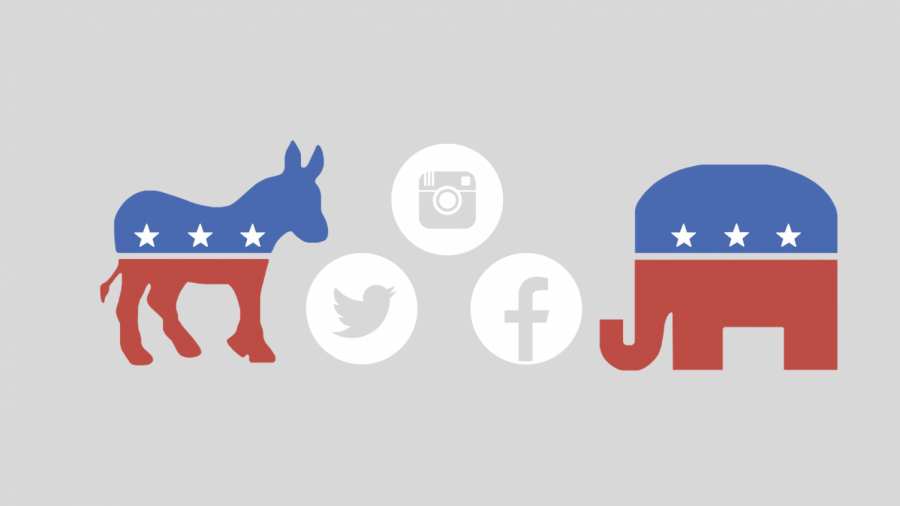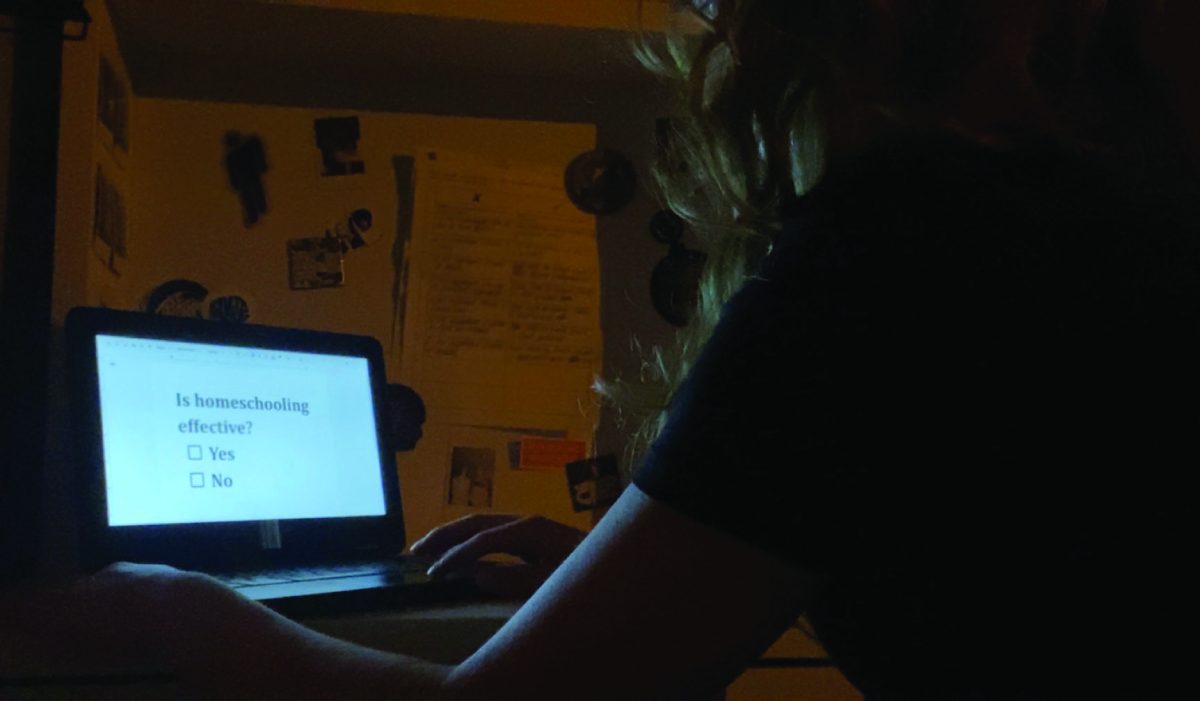Opinion: Divided We Fall
POLITICS, POLARIZATION AND PARTISANSHIP IN THE DIGITAL AGE
March 22, 2021
Events from the past year have been hard to ignore. A global pandemic. Wildfires in California. Protests across the country. A record-breaking presidential election. An insurrection at the Capitol. The first-ever second impeachment of a president. While these events would already be hard to ignore, the constant stream of information available at everyone’s fingertips makes it almost impossible. Social media has made the exchange of information even easier, with millions of photos and videos being posted daily. With all the chaos that has ensued in this decade thus far, there has been a visible surge in young political activism and voting.
The 2020 presidential election was not only record-breaking in terms of overall voter turnout, with Joe Biden receiving the most votes a presidential candidate has ever won, with 81,283,098. Even Donald Trump, who lost this election, won more votes than any presidential candidate before him, with 74,222,958. Young voters, who notoriously have the lowest voter turnout, went from 46.1 percent of eligible voters showing up to the polls in 2016 to approximately 52-55 percent in 2020, according to data from the U.S. Census Bureau. This may not sound like much, but 10 million young voters turned up for this election.
In a world where a constant stream of information is available to young voters via their phones, it’s no surprise that more and more youth are interested in politics. However, this easy access to information also has its risks. A young person who is seeking to become more political needs to be cautious about who they are listening to.
As someone who has been politically invested for years, Lincoln Southeast High School (LSE) senior Lewis Reimer, offers a piece of wisdom to those who are just beginning their political awakening.
“The best way to get involved is to first stick with the less polarizing and less opinionated news,” he says. “I try to get a variety. My main [sources are] BBC News and Reuters News. When I’m in the car, I’ll listen to conservative talk radio (such as) Rush Limbaugh and Sean Hannity.” Since Reimer has such vastly different views than Limbaugh and Hannity, he utilizes their voices to challenge his own beliefs and better understand viewpoints that don’t match his own.
Reimer, who has campaigned for Bernie Sanders and Christa Yoakum, emphasized that being informed is one of the best ways to be politically involved, stating that “If you just know how a policy will affect yourself and logically if everyone knew how it would affect themselves, then the majority would always get their way and it would always help the majority, which is the purpose of democracy.”
Matt Gruhn (12), who has been involved in politics since the 2016 election, also suggests following a variety of media makers, saying that “I go out of my way to look at as many news sources as I can. I read a ton of opinion articles from a bunch of different sources.”
Reimer and Gruhn have been known to get into heated debates about politics. However, they are both very aware of the necessity of being informed. Being informed means taking a critical look at the sources that one pays attention to.
Gruhn specifically warns of the dangers of receiving information from social media. “Social media is important for calling people to action…the big problem I think stems from these 24-hour news cycles, because people take what they [social media posts] say constantly at face-value and when it’s breaking news that’s especially a bad idea. On my Instagram, I can look at more liberal posts and more conservative posts and on either side, there are some very wildly outlandish claims out there that have no basis to support them.”
According to the New York Times, the number of countries with political disinformation campaigns on social media have doubled in the past two years. Not only that, but according to Facebook’s very own Internal Facebook Report, in 2018, 64 percent of people who joined extremist groups on Facebook did so because the algorithms steered them there.
When we speak of democracy, accurate information is critical to making sound decisions. Even more mainstream networks, such as CNN and Fox, have their own political agendas. According to AllSides, a bias-checking company, mainstream media uses business models that reward sensationalism and partisanship.
There are certain cues that reflect bias found in many mainstream media sources. AllSides provides a list of 11 cues, along with examples from real, mainstream articles. The list includes but is not limited to: spin, unsubstantiated claims, opinion statements presented as facts, sensationalism/emotionalism, mudslinging/ad hominem, mind reading, slant, flawed logic, bias by omission, omission of source attribution and bias by placement. Each of the cues listed are subtle most of the time, but are present in sources that range from The Washington Post, The Daily Wire, The Hill, Vox, Fox, BBC, AP, Reason, CNN, and more. This is why cross-checking sources is vital. If one simply uses Instagram headlines from sources that have similar perspectives, the full picture isn’t present. Even if one is reading in-depth articles from news sources that have similar perspectives or biases, again, the full picture isn’t present. This goes for both sides of the political spectrum.
Division in the United States also seems to be on the rise. Social media algorithms have been a large part of keeping political parties polarized. Netflix’s “The Social Dilemma” takes a deep-dive into social media’s impacts on people and warns against trusting everything you see.
Reimer says to those interested in politics who have an understanding of the political atmosphere, “It’s our right to start watching or listening (to) or reading opinionated articles on either side, left or right…(However) you still don’t want to just get your information from the opinionated sources.”
Gruhn urges students invested in politics to not let politics come between important relationships. “Right now things are so divided, it’s so common that people who become political end up letting it come between them and their friends or their friends let it come between them in whatever way. I would recommend not doing that mainly because (of) the echo chamber of social media. And that’s easy to do in real life where you just surround yourself with people who consistently agree with you and you never have to actually challenge your own beliefs.”
Polarization in the United States has intensified over recent years and this can easily cause division in relationships. Gruhn acknowledges that tolerance isn’t always possible but sees its value, “So long as your friends’ personal beliefs are not intentionally harming anyone that you know, or they’re not being bullies because of their beliefs, if they just possess those beliefs and you disagree with them, that’s no reason that you should stop being friends with them.”
Young students interested in learning more about politics must take the words they see on social media, and even mainstream news sites, with a grain of salt. Even in my own article, go back up to the very beginning. What words did I use to describe the events of the 2020s? If I had used the word “riot” instead of “protest”, would you envision something different? Or if I called the break-in at the Capitol a “protest” instead of an “insurrection”? It’s small details like these that make all the difference.
Being involved in politics is incredibly important, but it also comes with responsibility. One must look at articles critically, ask tough questions, challenge their beliefs and constantly seek the truth.










